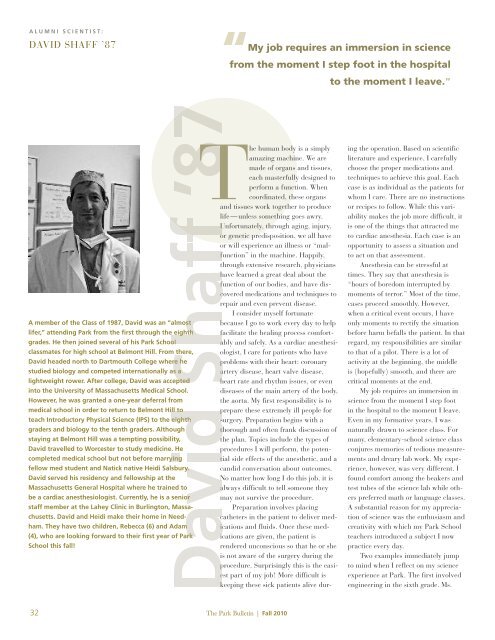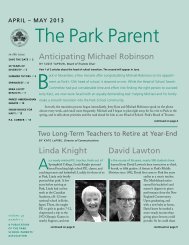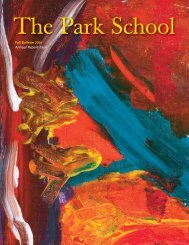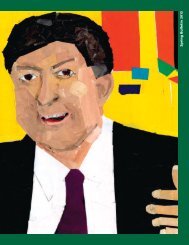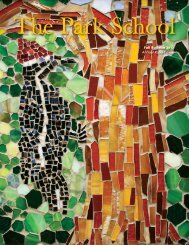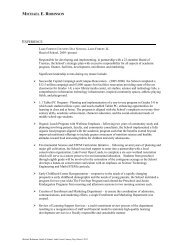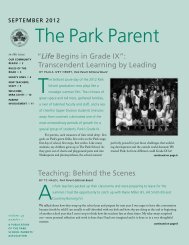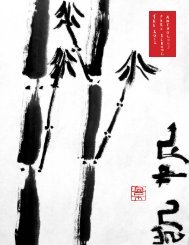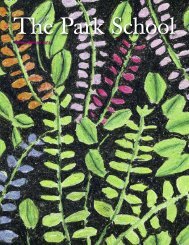⢠ParkBulletinCover - The Park School
⢠ParkBulletinCover - The Park School
⢠ParkBulletinCover - The Park School
- No tags were found...
Create successful ePaper yourself
Turn your PDF publications into a flip-book with our unique Google optimized e-Paper software.
A L U M N I S C I E N T I S T :DAVID SHAFF ’87My job requires an immersion in sciencefrom the moment I step foot in the hospitalto the moment I leave.A member of the Class of 1987, David was an “almostlifer,” attending <strong>Park</strong> from the first through the eighthgrades. He then joined several of his <strong>Park</strong> <strong>School</strong>classmates for high school at Belmont Hill. From there,David headed north to Dartmouth College where hestudied biology and competed internationally as alightweight rower. After college, David was acceptedinto the University of Massachusetts Medical <strong>School</strong>.However, he was granted a one-year deferral frommedical school in order to return to Belmont Hill toteach Introductory Physical Science (IPS) to the eighthgraders and biology to the tenth graders. Althoughstaying at Belmont Hill was a tempting possibility,David travelled to Worcester to study medicine. Hecompleted medical school but not before marryingfellow med student and Natick native Heidi Salsbury.David served his residency and fellowship at theMassachusetts General Hospital where he trained tobe a cardiac anesthesiologist. Currently, he is a seniorstaff member at the Lahey Clinic in Burlington, Massachusetts.David and Heidi make their home in Needham.<strong>The</strong>y have two children, Rebecca (6) and Adam(4), who are looking forward to their first year of <strong>Park</strong><strong>School</strong> this fall!<strong>The</strong> human body is a simplyamazing machine. We aremade of organs and tissues,each masterfully designed toperform a function. Whencoordinated, these organsand tissues work together to producelife —unless something goes awry.Unfortunately, through aging, injury,or genetic predisposition, we all haveor will experience an illness or “malfunction”in the machine. Happily,through extensive research, physicianshave learned a great deal about thefunction of our bodies, and have discoveredmedications and techniques torepair and even prevent disease.I consider myself fortunatebecause I go to work every day to helpfacilitate the healing process comfortablyand safely. As a cardiac anesthesiologist,I care for patients who haveproblems with their heart: coronaryartery disease, heart valve disease,heart rate and rhythm issues, or evendiseases of the main artery of the body,the aorta. My first responsibility is toprepare these extremely ill people forsurgery. Preparation begins with athorough and often frank discussion ofthe plan. Topics include the types ofprocedures I will perform, the potentialside effects of the anesthetic, and acandid conversation about outcomes.No matter how long I do this job, it isalways difficult to tell someone theymay not survive the procedure.Preparation involves placingcatheters in the patient to deliver medicationsand fluids. Once these medicationsare given, the patient isrendered unconscious so that he or sheis not aware of the surgery during theprocedure. Surprisingly this is the easiestpart of my job! More difficult iskeeping these sick patients alive duringthe operation. Based on scientificliterature and experience, I carefullychoose the proper medications andtechniques to achieve this goal. Eachcase is as individual as the patients forwhom I care. <strong>The</strong>re are no instructionsor recipes to follow. While this variabilitymakes the job more difficult, itis one of the things that attracted meto cardiac anesthesia. Each case is anopportunity to assess a situation andto act on that assessment.Anesthesia can be stressful attimes. <strong>The</strong>y say that anesthesia is“hours of boredom interrupted bymoments of terror.” Most of the time,cases proceed smoothly. However,when a critical event occurs, I haveonly moments to rectify the situationbefore harm befalls the patient. In thatregard, my responsibilities are similarto that of a pilot. <strong>The</strong>re is a lot ofactivity at the beginning, the middleis (hopefully) smooth, and there arecritical moments at the end.My job requires an immersion inscience from the moment I step footin the hospital to the moment I leave.Even in my formative years, I wasnaturally drawn to science class. Formany, elementary-school science classconjures memories of tedious measurementsand dreary lab work. My experience,however, was very different. Ifound comfort among the beakers andtest tubes of the science lab while otherspreferred math or language classes.A substantial reason for my appreciationof science was the enthusiasm andcreativity with which my <strong>Park</strong> <strong>School</strong>teachers introduced a subject I nowpractice every day.Two examples immediately jumpto mind when I reflect on my scienceexperience at <strong>Park</strong>. <strong>The</strong> first involvedengineering in the sixth grade. Ms.32 <strong>The</strong> <strong>Park</strong> Bulletin | Fall 2010


